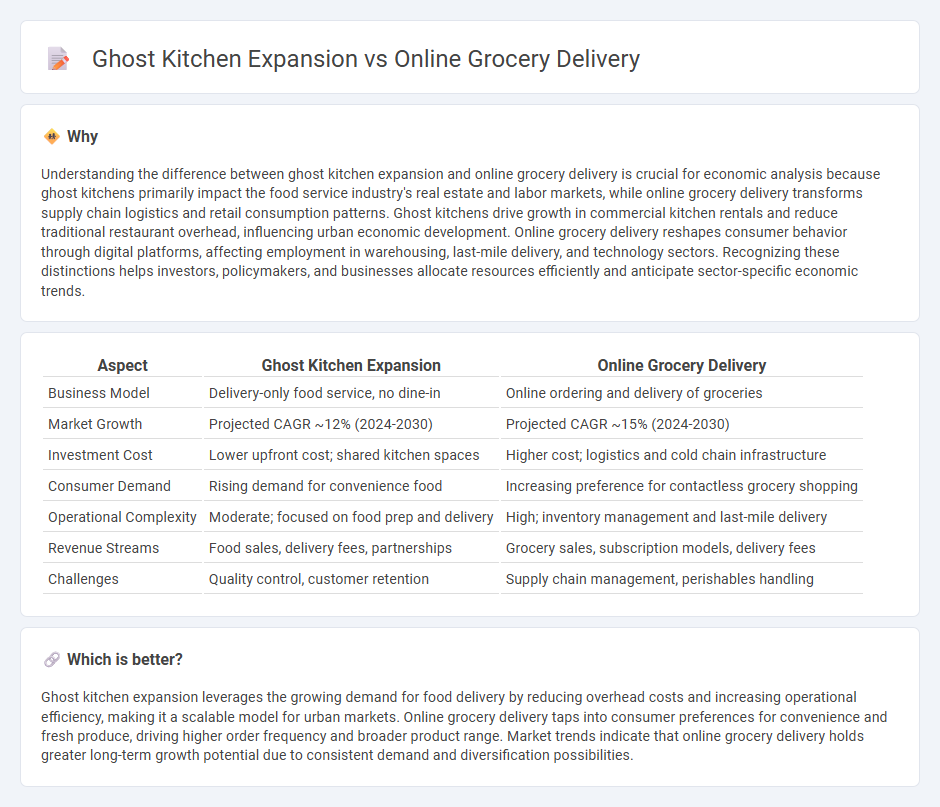
The rapid growth of ghost kitchens is reshaping the food service industry by reducing overhead costs and enabling scalable delivery operations in urban areas. In contrast, online grocery delivery services capitalize on expanding consumer demand for convenience and fresh produce, driving significant investments in last-mile logistics and cold chain technology. Explore the evolving economic impact and future potential of these two transformative market segments.
Why it is important
Understanding the difference between ghost kitchen expansion and online grocery delivery is crucial for economic analysis because ghost kitchens primarily impact the food service industry's real estate and labor markets, while online grocery delivery transforms supply chain logistics and retail consumption patterns. Ghost kitchens drive growth in commercial kitchen rentals and reduce traditional restaurant overhead, influencing urban economic development. Online grocery delivery reshapes consumer behavior through digital platforms, affecting employment in warehousing, last-mile delivery, and technology sectors. Recognizing these distinctions helps investors, policymakers, and businesses allocate resources efficiently and anticipate sector-specific economic trends.
Comparison Table
| Aspect | Ghost Kitchen Expansion | Online Grocery Delivery |
|---|---|---|
| Business Model | Delivery-only food service, no dine-in | Online ordering and delivery of groceries |
| Market Growth | Projected CAGR ~12% (2024-2030) | Projected CAGR ~15% (2024-2030) |
| Investment Cost | Lower upfront cost; shared kitchen spaces | Higher cost; logistics and cold chain infrastructure |
| Consumer Demand | Rising demand for convenience food | Increasing preference for contactless grocery shopping |
| Operational Complexity | Moderate; focused on food prep and delivery | High; inventory management and last-mile delivery |
| Revenue Streams | Food sales, delivery fees, partnerships | Grocery sales, subscription models, delivery fees |
| Challenges | Quality control, customer retention | Supply chain management, perishables handling |
Which is better?
Ghost kitchen expansion leverages the growing demand for food delivery by reducing overhead costs and increasing operational efficiency, making it a scalable model for urban markets. Online grocery delivery taps into consumer preferences for convenience and fresh produce, driving higher order frequency and broader product range. Market trends indicate that online grocery delivery holds greater long-term growth potential due to consistent demand and diversification possibilities.
Connection
The expansion of ghost kitchens accelerates online grocery delivery by optimizing food preparation and reducing overhead costs, enabling faster, cost-effective meal options. Both models leverage digital platforms to meet rising consumer demand for convenience and contactless services. This synergy drives significant growth in the on-demand economy, reshaping food service and retail sectors.
Key Terms
Last-mile logistics
Online grocery delivery and ghost kitchen expansion both heavily rely on efficient last-mile logistics to meet customer expectations for speed and reliability. Grocery delivery requires temperature-controlled transport to preserve freshness, while ghost kitchens focus on rapid food preparation and delivery, often within tight urban areas to reduce delivery times and operational costs. Explore how innovations in last-mile logistics are transforming these sectors for seamless customer experiences.
Unit economics
Unit economics in online grocery delivery reveal tight margins driven by high last-mile delivery costs, perishability, and intense competition requiring scale to achieve profitability. Ghost kitchen expansion benefits from lower overheads and flexible menu offerings, enabling better contribution margins and faster unit-level breakeven, though customer acquisition remains critical. Explore how these dynamics shape strategic investments and growth in the evolving food and grocery sectors.
Supply chain integration
Online grocery delivery requires a highly integrated supply chain that manages perishable goods with real-time inventory tracking, efficient cold storage, and last-mile delivery logistics to meet consumer expectations for freshness and speed. Ghost kitchens emphasize seamless supply chain coordination for ingredients and packaging materials, optimizing order fulfillment from multiple food brands within a centralized kitchen to reduce overhead and enhance delivery efficiency. Explore further insights into how supply chain integration drives innovation in both online grocery delivery and ghost kitchen growth.
Source and External Links
Costco Grocery Online Delivery - Costco offers online grocery delivery with options for Same-Day Delivery via Instacart for perishable items and 2-Day Delivery for non-perishables, with order minimums and availability varying by region.
Safeway: Grocery Delivery Near You - Order Groceries Online - Safeway allows online grocery orders for delivery or pickup, offering first-time customers $30 off a $75+ order placed directly through their website or app, excluding third-party platforms.
Online Grocery Delivery Service Near You - Order ... - Kroger - Kroger provides online grocery delivery within as little as two hours via Instacart, with options for Express Delivery for faster service, personal shoppers, and fees applicable depending on delivery speed.
 dowidth.com
dowidth.com